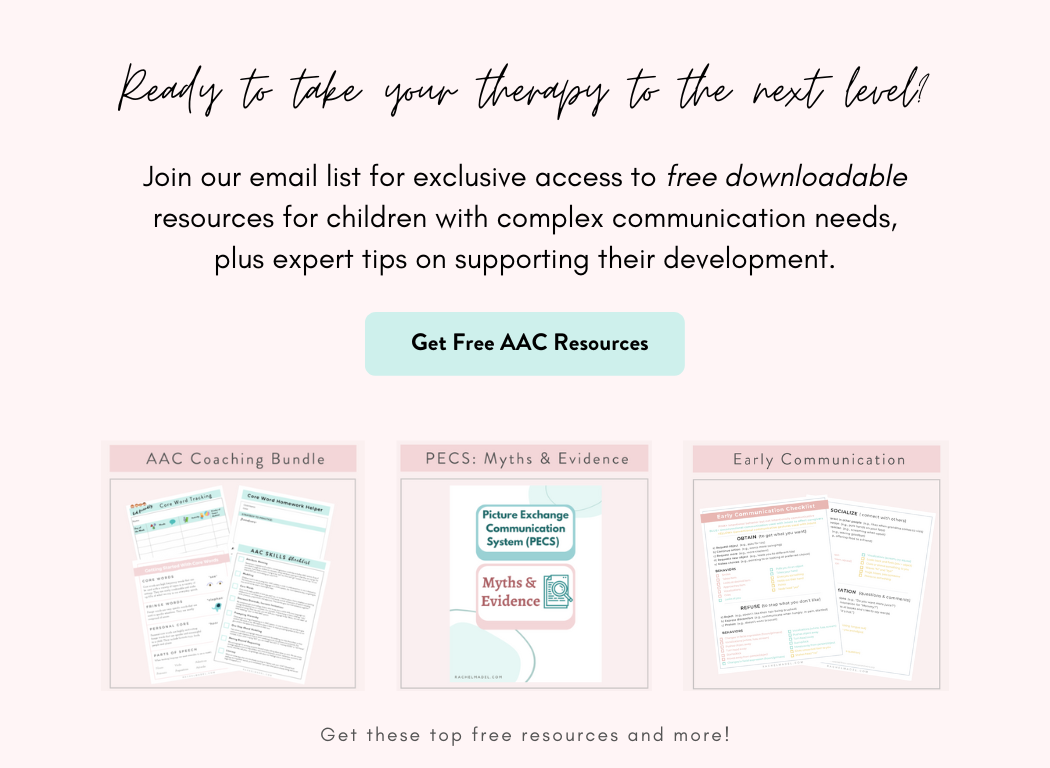Decreasing Demands and Increasing Invitations
I love the quote from Caroline Musselwhite: “Decrease demands and Increase Invitations. I often witness communication partners using demanding language like “What do you want?” or “Tell me with your device.” in order to elicit communication. While this might seem helpful, this type of language often results in children feeling pressured rather than encouraged to communicate. Instead, we can make a subtle shift in our language to be more enticing. For instance, if a child wants crackers, you might naturally comment, “Mmm, crackers!” or “Yes, I love crackers.” When you use commenting like this you’re modeling language in a way that invites communication without demanding it.
I always start simply commenting about what’s happening FIRST to see if that’s enough to inspire communication.
Start building awareness of the types of language you’re using to encourage communication with AAC. Aim for your interactions to sound more like natural conversations.
Here are my favorite strategies to encourage communication:
Exposure to a Specific Word Repeatedly
First we need to give a child a lot of exposure to a specific word/phrase. For example, if I’m teaching the word “OPEN,” I immerse children in that word by modeling it frequently on their AAC system during motivating activities.
This could be opening up the refrigerator for a snack, opening up a game box or opening the door to go outside. Once I've given lots of repeated exposure to teach this word, it's time to start following the least-to-most prompting hierarchy.
Tempt and Pause
Pick a familiar routine like opening up the refrigerator. The first step is to simply tempt and pause. This might mean that you put your hand on the refrigerator door to tempt and then pause and wait a communication attempt. Make sure the device is easily accessible to your child and be sure to recognize ANY attempt at communication… even if it doesn’t feel “accurate.”
A child doesn’t have to select the “correct” word. The key here is that we're giving the child the space to have an idea and then independently initiate communication with us. If they use a word that doesn’t make sense we can simply attribute meaning to that word.
Use Body Language
Let’s say the child doesn’t respond to tempting and pausing. You can use body language like a facial expression like raising your eyebrows or shrugging your shoulders as if to say “I don’t know. ” This can be enough to cue them to think: "let me say something on my AAC.”
Ask an Open-Ended Question/ Provide a Comment
If the child still doesn’t respond, then you can ask an open-ended question, such as “Now what?” or a comment like, “Hmm, I wonder what we should do next…”
Ask for a Specific Response
Still no response? You might try asking a more specific question like “What do you want?” or “Tell me with your talker.”
Point to the Device/Word
If a child continues to need help you might give more support by pointing to their device or even pointing to the word “OPEN” on their device.
I never venture into physical prompting because it violates bodily autonomy AND I haven’t found it to be useful in supporting independence down the line.
If I’m not getting a response it tells me either the child isn’t motivated by the activity I’ve chosen OR they haven’t had enough modeling or teaching with the specific word/phrase I’m targeting to use it on their own.
Avoid Over-Prompting
The reality is that the more support and prompting we give, the more reliant our students will become on that high level of support. The secret art of amazing therapy is pushing kids out of the comfort zone just enough so that they are able to start learning and growing. When we give children space and time to formulate their ideas into communication we are supporting a broader vision of helping our students become as independent as possible when it comes to sharing their thoughts and connecting with those around them.
Watch this video about How Over-Prompting Kills Spontaneous Language







